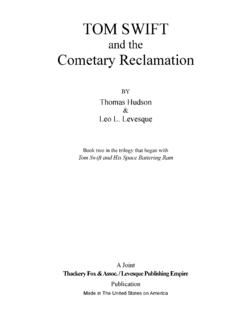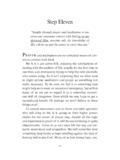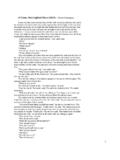Transcription of Basic Physics - PEACEONE
1 2 Basic Physics2-1 IntroductionIn this chapter, we shall examine the most fundamental ideas that we haveabout Physics the nature of things as we see them at the present time. We shallnot discuss the history of how we know that all these ideas are true; you willlearn these details in due things with which we concern ourselves in science appear in myriad forms,and with a multitude of attributes. For example, if we stand on the shore and lookat the sea, we see the water, the waves breaking, the foam, the sloshing motionof the water, the sound, the air, the winds and the clouds, the sun and the bluesky, and light; there is sand and there are rocks of various hardness and perma-nence, color and texture. There are animals and seaweed, hunger and disease, andthe observer on the beach; there may be even happiness and thought.
2 Any otherspot in nature has a similar variety of things and influences. It is always as com-plicated as that, no matter where it is. Curiosity demands that we ask questions,that we try to put things together and try to understand this multitude of aspectsas perhaps resulting from the action of a relatively small number of elementalthings and forces acting in an infinite variety of example: Is the sand other than the rocks? That is, is the sand perhapsnothing but a great number of very tiny stones? Is the moon a great rock? If weunderstood rocks, would we also understand the sand and the moon? Is the winda sloshing of the air analogous to the sloshing motion of the water in the sea?What common features do different movements have? What is common to dif-ferent kinds of sound?
3 How many different colors are there? And so on. In thisway we try gradually to analyze all things , to put together things which at firstsight look different, with the hope that we may be able to reduce the number ofdifferent things and thereby understand them few hundred years ago, a method was devised to find partial answers tosuch questions. Observation, reason, and experiment make up what we call thescientific method. We shall have to limit ourselves to a bare description of ourbasic view of what is sometimes called fundamental Physics , or fundamental ideaswhich have arisen from the application of the scientific do we mean by "understanding" something? We can imagine that thiscomplicated array of moving things which constitutes "the world" is somethinglike a great chess game being played by the gods, and we are observers of the do not know what the rules of the game are; all we are allowed to do is towatch the playing.
4 Of course, if we watch long enough, we may eventually catchon to a few of the rules. The rules of the game are what we mean by fundamentalphysics. Even if we knew every rule, however, we might not be able to under-stand why a particular move is made in the game, merely because it is too com-plicated and our minds are limited. If you play chess you must know that it iseasy to learn all the rules, and yet it is often very hard to select the best move orto understand why a player moves as he does. So it is in nature, only much moreso; but we may be able at least to find all the rules. Actually, we do not have allthe rules now. (Every once in a while something like castling is going on that westill do not understand.) Aside from not knowing all of the rules, what we reallycan explain in terms of those rules is very limited, because almost all situations areso enormously complicated that we cannot follow the plays of the game using therules, much less tell what is going to happen next.
5 We must, therefore, limit our-selves to the more Basic question of the rules of the game. If we know the rules,we consider that we "understand" the Introduction2-2 Physics before 19202-3 Quantum physics2-4 Nuclei and particlesHow can we tell whether the rules which we "guess" at are really right if wecannot analyze the game very well? There are, roughly speaking, three ways. First,there may be situations where nature has arranged, or we arrange nature, to besimple and to have so few parts that we can predict exactly what will happen,and thus we can check how our rules work. (In one corner of the board there maybe only a few chess pieces at work, and that we can figure out exactly.)A second good way to check rules is in terms of less specific rules derivedfrom them.
6 For example, the rule on the move of a bishop on a chessboard isthat it moves only on the diagonal. One can deduce, no matter how many movesmay be made, that a certain bishop will always be on a red square. So, withoutbeing able to follow the details, we can always check our idea about the bishop'smotion by finding out whether it is always on a red square. Of course it will be,for a long time, until all of a sudden we find that it is on a black square (whathappened of course, is that in the meantime it was captured, another pawn crossedfor queening, and it turned into a bishop on a black square). That is the way it isin Physics . For a long time we will have a rule that works excellently in an over-allway, even when we cannot follow the details, and then some time we may discovera new rule.
7 From the point of view of Basic Physics , the most interesting phenomenaare of course in the new places, the places where the rules do not work not theplaces where they do work! That is the way in which we discover new third way to tell whether our ideas are right is relatively crude but prob-ably the most powerful of them all. That is, by rough approximation. While wemay not be able to tell why Alekhine moves this particular piece, perhaps we canroughly understand that he is gathering his pieces around the king to protect it,more or less, since that is the sensible thing to do in the circumstances. In thesame way, we can often understand nature, more or less, without being able to seewhat every little piece is doing, in terms of our understanding of the first the phenomena of nature were roughly divided into classes, like heat,electricity, mechanics, magnetism, properties of substances, chemical phenomena,light or optics, x-rays, nuclear Physics , gravitation, meson phenomena, etc.
8 How-ever, the aim is to see complete nature as different aspects of one set of is the problem in Basic theoretical Physics , today to find the laws behindexperiment; to amalgamate these classes. Historically, we have always been ableto amalgamate them, but as time goes on new things are found. We were amalga-mating very well, when all of a sudden x-rays were found. Then we amalgamatedsome more, and mesons were found. Therefore, at any stage of the game, it alwayslooks rather messy. A great deal is amalgamated, but there are always many wiresor threads hanging out in all directions. That is the situation today, which we shalltry to historic examples of amalgamation are the following. First, take heatand mechanics. When atoms are in motion, the more motion, the more heat thesystem contains, and so heat and all temperature effects can be represented by thelaws of mechanics.
9 Another tremendous amalgamation was the discovery of therelation between electricity, magnetism, and light, which were found to be dif-ferent aspects of the same thing, which we call today the electromagnetic amalgamation is the unification of chemical phenomena, the variousproperties of various substances, and the behavior of atomic particles, which is inthe quantum mechanics of question is, of course, is it going to be possible to amalgamate everything,and merely discover that this world represents different aspects of one thing?Nobody knows. All we know is that as we go along, we find that we can amalga-mate pieces, and then we find some pieces that do not fit, and we keep trying toput the jigsaw puzzle together. Whether there are a finite number of pieces, andwhether there is even a border to the puzzle, is of course unknown.
10 It will neverbe known until we finish the picture, if ever. What we wish to do here is to see towhat extent this amalgamation process has gone on, and what the situation is atpresent, in understanding Basic phenomena in terms of the smallest set of express it in a simple manner, what are things made of and how few elementsare there ?2-22-2 Physics before 1920It is a little difficult to begin at once with the present view, so we shall firstsee how things looked in about 1920 and then take a few things out of that 1920, our world picture was something like this: The "stage" on whichthe universe goes is the three-dimensional space of geometry, as described byEuclid, and things change in a medium called time. The elements on the stage areparticles, for example the atoms, which have some properties.






